Stephen W. Hiemstra's Blog, page 68
April 11, 2023
Knopf Exercises Core
 Karl Knopf. 2012. Core Strength for 50+. Berkeley: Ulysses Press.
Karl Knopf. 2012. Core Strength for 50+. Berkeley: Ulysses Press.
Review by Stephen W. Hiemstra
In 2012 I worked for 3 months in an Alzheimer’s unit associated with a local hospital. One of the critical features of life in the unit was the question of mobility, strength, and stability. Loss of mobility was often the kiss of death because bed-ridden residents would suffer muscle atrophy, depression, and decline—even death. The triggering event is most frequently a fall. Consequently, physical therapy—usually simple exercises—was critical to health maintenance and longevity.
Interest in “core exercises” arose out of the increasingly sophisticated field of sports medicine. The core is “the region from the tops of the legs to the shoulder” (8). Just likely the elderly, professional athletes are prone to injury although they heal better than older people. National attention was drawn to core exercises in the early 1980s when it is was used San Francisco 49er quarterback, Joe Montana (9).
The motivation for adding core exercises to your routine arises because:
“Having an aligned and strong yet flexible core can take the load off the vertebral column and discs [lower back], which results in improved function and less discomfort and pain” (8).
The benefits of core exercises include both preventative and rehabilitation objectives:
“improved posture, which allows you to present a more youthful appearance [not bent over like many elderly people], and balance. It also means less load on the lumbar region of your low back, reducing the risk of injury to any arthritic joints and discs in addition to pain. Performance in sports and recreational pursuits is also boosted.” (13-14)
I wish that I had been introduced to such exercises as a young person because in junior high school I injured my back tube-surfing at the ocean and suffered severe lower back pain episodically ever since. In 2008, the pain was so bad that I was on my back for 3 days in a row twice during the summer. After visiting a back specialist, I added Pilates exercises, a kind of core exercise, before my daily swim.
Karl Knopf’s book, Core Strength for 50+, draws on the author’s experience with both the elderly and professional athletes. Knopf is a professor emeritus of Foothill College and longtime director of senior fitness with the International Sports Science Association (127). He is also the author of numerous exercise books (125). Knopf divides his book into 3 parts:
Getting Started
The Programs and
The Exercises (v).
His introduction is part of part 1. Following part 3 are a topical index, acknowledgments, and a brief biography of the author.
Knopf divides core training into 4 stages:
Leaning to contract deep-lying muscles.
Focus on endurance of those muscles.
Challenges to the core with arm motions. And
Additional challenges to the core (14).
The attitude appropriate for these exercises is important. Knopf sees these principles as key:
Concentration and perseverance.
Quality of movement is more important than quantity.
Slow, purposeful progression to more challenging movements. and
The ability to perform every action from a neutral spine (15).
This last point came as a surprise. Knopf is very concerned with proper posture. He writes: “Learning to sit, stand, and move in the most biomechanical manner is foundational.” He advises: “If you want to look young, stand tall.” (16) After reading this, I became very self-conscious how I walked…
The philosophy of core training is likewise a bit different. Knopf writes: “The key to a well-aligned core is to strengthen that which is weak and lengthen that which is inflexible.” (22) The way this is done explains all the exotic equipment found around gyms these days—big round plastic balls, form rubber rollers, kettle bells, etc. Exercising with unstable surfaces, like doing push-ups with a plastic ball in one hand, engages more muscle groups in the core (23).
Karl Knopf’s book, Core Strength for 50+, is an interesting and helpful book. Not only did reading it help me understand my own exercise routine—the Pilates—but I also appreciated the update on the exotic gym equipment. Exotic no longer seems so exotic.
I have changed my exercise routine; you may too.
Footnotes
http://pilates.about.com/od/whatispil...
12345 El Monte Road, Los Altos Hills, CA 94022. (http://www.FootHill.edu).
https://www.linkedin.com/pub/dr-karl-....
Knopf Exercises Core
Also see:
Books, Films, and Ministry
The Who Question
Preface to a Life in Tension
Other ways to engage online:
Author site: http://www.StephenWHiemstra.net
Publisher site: http://www.T2Pneuma.com
Newsletter: https://bit.ly/Spring_23 , Signup
The post Knopf Exercises Core appeared first on T2Pneuma.net.
April 10, 2023
Faithfulness: Monday Monologues (podcast), April 10, 2023

By Stephen W. Hiemstra
This morning I will share a prayer and reflect on Faithfulness. After listening, please click here to take a brief listener survey (10 questions).
To listen, click on this link.
Hear the words; Walk the steps; Experience the joy!
Faithfulness: Monday Monologues (podcast), April 10, 2023
Also see:
The Face of God in the Parables
The Who Question
Preface to a Life in Tension
Other ways to engage online:
Author site: http://www.StephenWHiemstra.net
Publisher site: http://www.T2Pneuma.com
Newsletter: https://bit.ly/Spring_23 , Signup
The post Faithfulness: Monday Monologues (podcast), April 10, 2023 appeared first on T2Pneuma.net.
April 9, 2023
Mark 16: Easter
 “And he said to them, Do not be alarmed. You seek Jesus of Nazareth, who was crucified.
“And he said to them, Do not be alarmed. You seek Jesus of Nazareth, who was crucified.
He has risen; he is not here. See the place where they laid him” (Mark 16:6 ESV).
By Stephen W. Hiemstra
One of the most vivid memories I have as a young person was the experience of an Easter sunrise. Easter is mysterious, earth-shattering news. How could I sleep through it?
FuneralAt my grandfather’s funeral, I was given a head of wheat which hangs now in my kitchen. The wheat reminds me of Jesus’ saying: “Truly, truly, I say to you, unless a grain of wheat falls into the earth and dies, it remains alone; but if it dies, it bears much fruit” (John 12:24 ESV).
Resurrection RemindersThe mystery of resurrection is everywhere in nature. Sunrise is the resurrection of the day. Springtime is the resurrection of the seasons. The metamorphosis from caterpillar to cocoon to adult butterfly is a beautiful, dramatic resurrection. The Apostle Paul writes: “all of creation groans in anticipation of our redemption” (Romans 8:19-23).
Messianic PropheciesProphesies of Jesus’ resurrection start early in scripture. Systematic theologians see salvation history as creation, fall, and redemption. Because sin is the cause of death, eternal life requires forgiveness of sin which is brought about in Christ’s resurrection. This transition is prophesied in Genesis: “I will put enmity between you and the woman, and between your offspring and her offspring; he shall bruise your head, and you shall bruise his heel” (Gen 3:15 ESV).
Other theologians see resurrection arising out of righteous suffering. The prophet Job writes not only of Christ, but his own resurrection: “For I know that my Redeemer lives, and at the last he will stand upon the earth. And after my skin has been thus destroyed, yet in my flesh I shall see God, whom I shall see for myself, and my eyes shall behold, and not another” (Job 19:25-27 ESV). At the birth of the church on Pentecost (Acts 2:27), the Apostle Peter sees resurrection prophesied by King David: “For you will not abandon my soul to Sheol, or let your holy one see corruption” (Psalm 16:10).
When asked to produce a sign Jesus himself spoke of the sign of Jonah (Luke 11:29-32). In the belly of the whale Jonah prayed: “I called out to the LORD, out of my distress, and he answered me; out of the belly of Sheol I cried, and you heard my voice” (Jonah 2:2 ESV). And the whale spit him out on dry land, another resurrection story.
Old Testament Resurrections AccountsResurrection did not start with Jesus. Some see the story of the binding of Isaac as a resurrection account and a prophecy of the cross (Genesis 22:1-18). The prophet Elisha raises the Shunammite’s son from the dead (2 Kings 4:32-37). In the valley of bones, Ezekiel prophesied about resurrection of the Nation of Israel (Ezekiel 37:3-6). The exodus of the nation of Israel from Egypt and the return of the exiles from Babylon are both resurrection accounts where a dead nation rises to new life.
New Testament Resurrection AccountsIn the gospels, Jesus himself performed several resurrections. He raised Jairus’s daughter from the dead (Mark 5:22-43). He raised the widow’s son (Luke 7:12-17). Most remarkably, after lying four days in the tomb he raised Lazarus from death (John 11:1-45). Like other resurrections, Jesus’ healings and exorcisms brought hope where there was none.
Some scholars believe that John Mark’s gospel recorded Apostle Peter’s testimony while he was in Rome during AD 41-54. Mark later traveled with Paul. Mark’s role was to teach about the life of Jesus. Later, Luke may have assumed this role in Paul’s missionary team.
Mark’s Unusual EndingInterestingly, Mark did no see the gospel ending with Jesus. Neither did Luke whose gospel was followed by the Book of Acts. Mark’s gospel starts with: “The beginning of the gospel of Jesus Christ, the Son of God” (Mark 1:1 ESV). Scholars believe that Mark’s gospel ends with the woman going out from the tomb to relay the angel’s message: “But go, tell his disciples and Peter that he is going before you to Galilee” (Mark 16:7 ESV). Likewise, our part in salvation history is to pass on the story. As the hymnist Katherine Hankey (1834-1911) writes: “I love to tell the story, of unseen things above, of Jesus and his glory, of Jesus and his love…” [2]
Christian HopeChristian hope starts with the resurrection: we know that death is not the end of life’s story. And because we know the rest of the story, we can invest in life and live each day with boldness and joy
FootnotesDid Abraham believe God would raise Isaac from the dead? Why did the angel have to tell Abraham twice?
[2] www.hymnsite.com/lyrics/umh156.sht
Mark 16: EasterAlso see:A Roadmap of Simple FaithChristian Spirituality Looking Back A Place for Authoritative Prayer Other ways to engage online:Author site: http://www.StephenWHiemstra.net, Publisher site: http://www.T2Pneuma.com. Newsletter: http://bit.ly/HailMary21The post Mark 16: Easter appeared first on T2Pneuma.net.
Prayer for Faithfulness and Truth
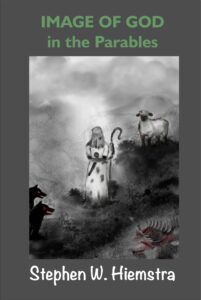
By Stephen W. Hiemstra
God of all wonders and truth,
All praise and honor, power and dominion, truth and justice are yours, because you honor truth and faithfully make yourself available to us in our hour of need.
We confess that we are more likely distracted when we should be available. Even when we don the clothe and take on a doctor’s scrubs, we have trouble being fully present to those in need whom we presumably serve. Forgive us.
Thank you for the example of Jesus of Nazareth and the presence of the Holy Spirit who give direction and grant us hope that we can more faithfully discharge our duties as Christians in a fallen world and truly witness to those around us.
In the power of your Holy Spirit, enable us to utilize the gifts that you have given us.
In Jesus’ precious name, Amen
Prayer for Faithfulness and Truth
Also see:
The Face of God in the Parables
The Who Question
Preface to a Life in Tension
Other ways to engage online:
Author site: http://www.StephenWHiemstra.net
Publisher site: http://www.T2Pneuma.com
Newsletter: https://bit.ly/Spring_23 , Signup
The post Prayer for Faithfulness and Truth appeared first on T2Pneuma.net.
April 8, 2023
Mark 15: Holy Saturday
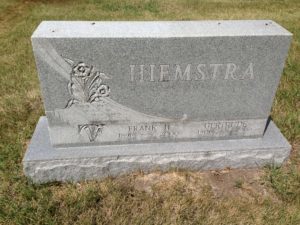 “And Joseph bought a linen shroud, and taking him down, wrapped him in the linen shroud
and laid him in a tomb that had been cut out of the rock.
“And Joseph bought a linen shroud, and taking him down, wrapped him in the linen shroud
and laid him in a tomb that had been cut out of the rock.
And he rolled a stone against the entrance of the tomb.” (Mark 15:46 ESV)
By Stephen W. Hiemstra
Jesus is buried on the Day of Preparation which ends at sundown when the Jewish Sabbath begins. This detail in Mark’s Gospel is important because burial was forbidden on the Sabbath and executed criminals could not hang overnight (Deut 21:23). The Gospels mention nothing taking place on the Sabbath while Jesus lay in the tomb and the narrative resumes on the following day. In other words, Jesus rested in the tomb over the Sabbath. Holy Saturday was a day of mourning and grief.
A Grieving HolidayGrief is more than crying. In Jesus’ Beatitudes, Matthew records: “Honored are those who mourn, for they shall be comforted.” (Matt 5:4) Luke records: “Honored are you who weep now, for you shall laugh.” (Luke 6:21) Both accounts of this Beatitude are written in the form of a lament which has two parts. In the first part, one empties the heart of all grief and pain and anxiety in prayer to God; in the second part, having been emptied the heart turns to God in praise. In the lament, when we grieve, we make room in our hearts for God.
The Theology of LamentThe most famous lament in the Bible is cited by the Gospel of Mark as Jesus’ last words: “My god, my god, why have you forsaken me?” (Mark 15:34) These words come from Psalm 22 verse one which turns to God in verse 19: “But You, O LORD, be not far off; O You my help, hasten to my assistance.” At a time when much of scripture was memorized, rabbis would cite the first part of a passage knowing that the audience would fill in the missing part. Knowing this tradition, Jesus could cite the first verse in Psalm 22 knowing that people hearing him would know the Psalm and how it ended.
Jesus gave us a template for dealing with grief the night before during his prayer in Gethsemane. Mark records that Jesus’ prayed three times: “Abba! Father! All things are possible for You; remove this cup from Me; yet not what I will, but what You will.” (Mark 14:36). Jesus is aware that he stands before the cross and does not want to die; still, he yields to God’s will. Each time we face pain and grief we are faced with a decision: do we turn to God or do we turn into our grief? Our identity is crafted from a lifetime of such decisions.
Joseph of ArimatheaThe story of Joseph of Arimathea is instructive. Mark records: “Joseph of Arimathea, a respected member of the council, who was also himself looking for the kingdom of God, took courage and went to Pilate and asked for the body of Jesus.” (Mark 15:43) Asking for the body of a man just crucified for sedition took guts. Yet, with no expectation of resurrection, on a day when Jesus’ inner circle was in hiding and in fear, Joseph “took courage” and asked Pilate for the body of Jesus. Then, he buried him in his own grave [4].
Holy Saturday Reveals our TheologyHoly Saturday is a time to reflect on Christ’s crucifixion. Are we among those happy to see Jesus in the tomb or are we looking forward to the kingdom of God like Joseph of Arimathea? This Gethsemane moment is one of many in this life. The answer to the implied question—Do we turn to God in our pain or sulk?—ultimately defines who we are because life includes many such Gethsemane moments and we have a special relationship with pain.
FootnotesBurial is work, hence forbidden on the Sabbath (e.g. Deut 5:12-15).
Also: Matthew 27:46. The direct citation of an Aramaic expression—“Eli, eli, lama sabachthani?” in both the Mark and Matthew accounts makes it more likely that these are the actual words of Jesus. This is because the most important expressions in the Bible are cited directly rather than translated or, in this case, the actual words are both cited and translated.
Jesus does exactly that in Matthew 21:16 citing Psalm 8:2.
[4] What a picture of substitutionary atonement—Jesus was buried in my grave so that I do not have to be.
Mark 15: Holy SaturdayAlso see:A Roadmap of Simple FaithChristian Spirituality Looking Back A Place for Authoritative PrayerOther ways to engage online:Author site: http://www.StephenWHiemstra.net, Publisher site: http://www.T2Pneuma.com. Newsletter: http://bit.ly/HailMary21The post Mark 15: Holy Saturday appeared first on T2Pneuma.net.
April 7, 2023
Mark 15: Good Friday
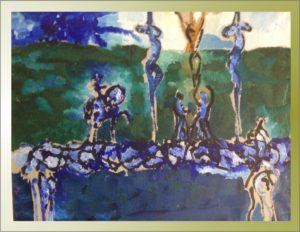
“And when the centurion, who stood facing him, saw that in this way he breathed his last, he said,
Truly this man was the Son of God!” (Mark 15:39 ESV)
By Stephen W. Hiemstra
Second TrialPontius Pilate gets right to the point: “Are you the King of the Jews?” Jesus answers with two words–σὺ λέγεις—which means: you say (Mark 15:2). The chief priests accuse him of many things. Pilate asks Jesus a second question: “Have you no answer to make?” (Mark 15:4) Jesus does not respond (Isaiah 53:7). Pilate is amazed.
First TrialThe night before, the high priest asked Jesus if he is the Messiah (Christ). Jesus responded using the words God from Exodus 3:14 saying: “I am”. Then, in case anyone misunderstood him, he paraphrased the messianic prophecy in Daniel 7:13: “you will see the Son of Man seated at the right hand of Power, and coming with the clouds of heaven” (Mark 14:62 ESV). The high priest accordingly accused Jesus of blasphemy which is punishable by stoning under Jewish law (Leviticus 24:16). But since Rome reserved the right to decide all cases of capital punishment, the chief priests accused Jesus of the political crime of sedition—treason against Rome. This is why Pilate asked Jesus: “Are you the King of the Jews?” (Mark 15:2)
What Kind of Messiah?Realizing that Jesus is innocent of the charge of sedition, like a good politician Pilate begins working the crowd. In offering to release a prisoner named Barabbas, who was guilty of both sedition and murder (Mark 15:7), Pilate is effectively asking the crowd what kind of Messiah they prefer. The crowd asked for Barabbas who was known to be a Jewish nationalist—in other words, the crowd prefers a kingly Messiah.
Messiah means anointed one in Hebrew which translates as Christ in Greek. Three types of roles are anointed: prophets, priests, and kings. In his earthly ministry, Jesus embodied the first two roles (prophet and priest), but the crowd wanted a king—someone to drive the Romans out—as we saw earlier in Mark 11:10.
So Pilate gave them what they wanted (Romans 1:24-25), washed his hands of the decision, and sent Jesus to the cross.
Mark 15: Good FridayAlso see:A Roadmap of Simple FaithChristian Spirituality Looking Back A Place for Authoritative Prayer Other ways to engage online:Author site: http://www.StephenWHiemstra.net, Publisher site: http://www.T2Pneuma.com. Newsletter: http://bit.ly/HailMary21The post Mark 15: Good Friday appeared first on T2Pneuma.net.
Applying Faith

Now faith is the assurance of things hoped for,
the conviction of things not seen.
(Heb 11:1)
By Stephen W. Hiemstra
In the parables examined, we begin to see the nature of God’s faithfulness and truth. The fifth characteristic of God in Exodus 34:6 is faithful, also translated as truthful. Often as not in the scriptures, the faithfulness and truthfulness of God is assumed, not described.
Parables of Truth and Faithfulness
The divine image of God lends stability to our lives that cannot be obtained any other way. In the Parable of the Two Builders, God is the rock on which our foundations are made secure. The rock of our salvation is a metaphor both for a disciplined lifestyle and for scientific study. Without that rock neither fruit of such stability is possible.
In the Parable of the Callous Judge, we are advised to study the wisdom of the world. Knowledge of the world is part of God’s truth. Paying attention to the principal agent problem, recognizing what motivates even evil people, may offend our sensibilities, but should be neglected as we faithfully attend to our role as stewards of our time and resources.
The Parable of the Pharisee and the Tax Collector reminds us that God is both transcendent (the object of our prayers) and immanent (able to hear our prayers). Even though God is beyond our comprehension, he loves us enough to always remain available. Whether we are faithful or naughty, we remain through faith part of God’s family.
The Parable of the Physician takes the form of a proverb and simple describes the role of a doctor in healing the sick. It is a brilliant statement of the obvious: Simple proverb; profound truth. Yet, doctors more often attend to the whims of the rich than to illnesses of those poor and sick. Furthermore, Jesus uses this proverb allegorically to describe his role as a rabbi and medical missionary.
Here we see Jesus highlighting the principal agent problem that afflicts religious leaders. Like the physician that serves as a personal doctor of the wealthy, religious leaders often spend more time with paying customers than with those in need of their care. This problem likely describes Jesus’ impatience and distain for religion leaders. The Parable of the Physician is accordingly one of Jesus’s more poignant parables and, because of its brevity, one of the most neglected among commentators.
Problem of Truth
More than other attributes of God described in Exodus 34:6, examples of parables directed specifically at truthfulness and faithfulness are hard to find. More often we observe lessons about truth and faith from the context and structure of the parables. Pilate’s question—What is Truth?—is not simply a throw-away comment (John 18:38). When we say that God is truth, we recognize the enigma at the heart of the concept.
Applying Faith
Also see:
The Face of God in the Parables
The Who Question
Preface to a Life in Tension
Other ways to engage online:
Author site: http://www.StephenWHiemstra.net
Publisher site: http://www.T2Pneuma.com
Newsletter: https://bit.ly/Spring_23 , Signup
The post Applying Faith appeared first on T2Pneuma.net.
April 6, 2023
Mark 14: Maundy Thursday
 Foot washing
Foot washing
“Three times a year all your males shall appear before the LORD your God at the place that he will choose: at the Feast of Unleavened Bread (הַמַּצּ֛וֹת), at the Feast of Weeks (הַשָּׁבֻע֖וֹת), and at the Feast of Booths (הַסֻּכּ֑וֹת; Deuteronomy 16:16 ESV).
By Stephen W. Hiemstra
Holy Week as we know it is often celebrated at the same time as the Jewish Feast of Unleavened Bread (Festival of Matzos) often called Passover. Dates differ because of differences in the calendar rules. In Jesus’ time, Passover was one of three festivals that required the faithful to travel to Jerusalem. The other festival familiar to Christians is the Feast of Weeks commonly known as Pentecost. The Feast of Booths is a harvest festival in the fall.
Passover BackstoryPassover commemorates the release of the Jewish people from slavery in Egypt. God instructed Moses to tell the Israelite to sacrifice a lamb and place the blood of the lamb over their door-posts so that the angel of death would pass them by. On the night of the Passover, the angel of death struck down the first born of Egypt and passed over the Israelite households. Pharaoh reacted immediately by expelling the Israelite slaves. They left so quickly that there was not time to bake bread for the journey. Instead, they prepared bread without letting the dough rise—unleavened bread (Exodus 12). Mark 14:12-26 describes how Jesus and his disciples celebrated the Passover meal in Jerusalem now remembered as the Last Super.
Covered by the BloodThe Last Super is important to Christians because it introduces the new covenant in Christ. The word, covenant, found in v. 24 appears nowhere else in Mark’s Gospel and alludes to the covenant meal that Moses and the Elders of Israel shared with God on Mount Sinai (Exodus 24:9-11). The grim symbolism of the wine as the blood of Christ is an allusion to the blood of the Passover lamb (Exodus 12:7) which alerted the angel of death to pass over households displaying the blood. In this sense, as Christians we are (like the door posts) covered by the blood of Christ. By Jesus’ blood our sins are forgiven and we are passed over (Hebrews 9:11-28).
Where Does Maundy Thursday Come From?Where does the name, Maundy Thursday, come from? One theory is that it is Middle English for the Latin word, Mandatum, which means command. According to some traditions, Maundy Thursday focuses on Jesus’ lesson on servant leadership: “If I then, your Lord and Teacher, have washed your feet, you also ought to wash one another’s feet” (John 13:14 ESV).
Mark 14: Maundy ThursdayAlso see:A Roadmap of Simple FaithChristian Spirituality Looking Back A Place for Authoritative Prayer Other ways to engage online:Author site: http://www.StephenWHiemstra.net, Publisher site: http://www.T2Pneuma.com. Newsletter: http://bit.ly/HailMary21The post Mark 14: Maundy Thursday appeared first on T2Pneuma.net.
April 4, 2023
Campbell on Gender Confusion
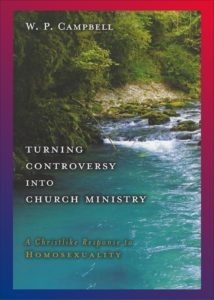
W. P. Campbell. 2010. Turning Controversy into Church Ministry: A Christlike Response to Homosexuality. Grand Rapids: Zondervan.
Review by Stephen W. Hiemstra
In 2012 during my first unit of Clinical Pastoral Education, I spent a lot of time in the emergency room (ER) of a local metro hospital. One afternoon the ER was packed and overflow patients were stationed on gurneys throughout the room. As I worked my way around the room, it became obvious that a patient on one of the gurneys with a friend in attendance wanted to see me. So I wandered over to talk with him.
I asked—What brings you to the hospital today? His answer caught me off guard—rectal bleeding. The shock on my face must have been obvious. Also obvious was the fear of death on the patient’s face. I should have probed into his demeanor—Was he perhaps concerned about HIV infection? Instead, I mumbled through a few pleasantries, offered prayer, and left. My lack of preparation for that hospital visit was clearly a lost ministry opportunity.
How do we properly minister to people caught up in gender confusion?
Introduction
Bill Campbell’s book, Turning Controversy into Church Ministry, focuses on confronting our fears and offering Christ’s presence to broken people. Campbell writes:
“This book is written to equip Christians and their churches to prove a Christlike response to homosexuality and to people who struggle with unwanted, same-sex attractions.” (7)
Woman Caught in Adultery
How does a pastor respond to someone seeking care for unwanted same-sex attractions? Campbell (11-12) starts with the story of the woman caught in adultery. Jesus asked:
“Woman, where are they? Has no one condemned you? She said, No one, Lord. And Jesus said, Neither do I condemn you; go, and from now on sin no more.” (John 8:10-11 ESV)
Campbell notes two principles in Jesus response: grace and truth [1]. Jesus starts with grace—defending the woman against her unfair accusers [2] and refusing to condemn her [3]. But he also admonishes her: go and sin no more. Campbell explains:
“Grace without truth pampers, confuses, and even deceives. Truth without grace cuts, wounds, and destroys…Salt is essential for the body, but separated into its two elements, sodium and chloride, it can be deadly.” (13)
He observes that the church has often reached out to those wounded by divorce, but has not done so with those that struggle with gender confusion (14).
Organization of Book
The book has three parts:
Analysis: Your Church, Christs Body.
Approach: Overcoming Controversy.
Action: Building Ministry.
Campbell starts with the current status of your church and then provides information both scriptural and practical about the major controversies in church responses to homosexuality. He finally talks about the ministry challenges in ministry to homosexuals and provides links to ministry resources.
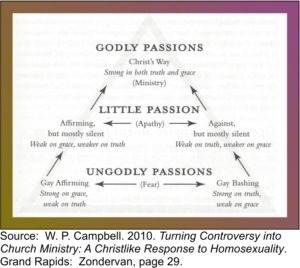
Analysis
Campbell’s guidance to churches is summarized in an interesting graphic (see right). He ranks churches based on their emotional response to homosexuality. Churches motivated by fear either blindly condemn or blindly embrace homosexuality. Churches motivated by apathy express support (or not) but mostly remain silent. Churches motivated by ministry remain biblically obedient but extend grace to those struggling with gender confusion, much like they would extend grace to alcoholics and other broken people (28-36). The ministry response that Campbell advocates is clearly neither common nor easy.
Campbell’s experience with homosexuality began with caring for his deaf son. Being the rare pastor who could sign, he found himself intimately involved in the deaf community and their particular problems. Deaf children often attend school in residual programs that leave them vulnerable to homosexual activity and exploitation (40). He writes:
“The compassion of Christ begins to bloom when [church] members begin to understand that homosexual attractions are usually not chosen by those who experience them but are the fallout of a multiplicity of factors such as prenatal dispositions, sexual abuse, parental detachment, and same-sex rejection.” (38)
He learned that at homosexual temptations are rooted in isolation and rejection (46).
Approach
The treatment of the science of homosexuality in the media and among psychiatrists offers a cautionary tale. Scientific studies have for the most part not been able to demonstrate a linkage between genetics and any behavioral trait in spite of great efforts to explain depression, gambling, propensity towards obesity and even criminal activity (83). A genetic linkage to homosexuality has likewise never been demonstrated even though much of this research has been done by groups and individuals anxious to find this linkage (82-89). Nevertheless, the media has consistently claimed linkages that the scientists themselves have not reported (83). The strongest statement that can be made based on research (as of 2010) is that some people may have a disposition that they may (or may not) act on—Campbell compares it to a general disposition towards intellectual pursuits (86). By comparison, alcoholism has been shown to be inheritable at a rate of 50-60 percent—the comparable figure for homosexuality is 50 percent or less (87). While the media has dramatically increased the visibility of homosexuality, the percentage reported in the population remains a low 2-3 percent (89).
An important part of the effort to mainstream homosexuality arose in changes in the treatment by psychiatrists. Research before the politicization of homosexuality pointed to the “distant father/overclose mother” theory, sexual abuse, and sexual experimentation as causal factors for homosexuality (110-113). In spite of research supporting these factors in 1973, the American Psychiatric Association (APA) voted after intense lobbying from homosexual groups to remove homosexuality from the list of psychiatric illnesses normally reported in the Diagnostic and Statistical Manual of Mental Disorders (DSM) (106-107). Because listing in the DSM is a prerequisite for insurance company reimbursement for treatment, this change lead to a dramatic decline in scientific research and treatment in the years that followed. Unfortunately, homosexuality was dropped from the DSM for political, not psychiatric, reasons. Still, some practitioners continue to see patients (110-117).
Action
Campbell sees ministry to homosexuals having 6 parallels to the efforts of Nehemiah to rebuild the city of Jerusalem, each having both an inner reality and outer focus:
Motivation–Prayer;
Vision–Leadership;
Healing–Family values;
Growth–Mentors and counselors;
Support–Small group ministry; and
Celebration–Outreach (153).
For example, Campbell notes that Nehemiah was a man of prayer. Before approaching the king with his request to assist in rebuilding Jerusalem, Nehemiah mourned, prayed, and fasted (Nehemiah 1). Opposition pushed Nehemiah closer to God (154). The point here is that Campbell sees ministry to those challenged by gender confusion requiring a range of responses corresponding to a range of needs.
Background
Bill Campbell is senior pastor of Hendersonville Presbyterian Church, Hendersonville, NC . He speaks from more than 20 years of ministry experience dealing with homosexuality. He recounts stories of families and individuals that he interviewed who have struggled with unwanted same-sex attractions and overcome them. His personal interface with the gay community arose from both family experiences and from his own ministry in a church located close to an AIDs clinic. He is passionate about the Gospel and has a shepherd’s heart for those in need.
Assessment
Campbell’s book is long overdue. From my own walk with the Lord, I was ministered to as a young person by staff and clergy who were later dismissed for gay relationships. In my role as clerk of session in my home church, I found myself whipsawed by church controversies over ordination standards with little guidance other than scripture and personal experiences. In ministry, I feel a need to be prepared both scripturally and practically for the challenges of helping broken people. Turning Controversy into Church Ministry has been a big help in overcoming my own fear of being faithful in this ministry.
Thanks Bill.
[1] Grace and truth are among God’s core values expressed in Exodus 34:6 immediately following the giving of the Ten Commandments. We know that these values are fundamental for God because they are repeated almost word for word in Psalm 86:15 and 103:8, Joel 2:13, and Jonah 4:2.
[2] The law is clear, both the man and woman who commit adultery are liable to be put to death (Lev 20:1). The woman’s accusers obviously know who the man is and have hidden him from the law.
[3] Under the Mosaic law, at least 2 witnesses are required in a death penalty case. By law, the witnesses must be the first to cast a stone (Deut 17:6-7). Perjury carries the same penalty as the alleged crime (Deut 19:15-19).
http://www.hendersonvillepc.org.
Campbell on Gender Confusion
Also see:
Fortson and Grams Bible Limits Sex to Christian Marriage, Part 1
Webb: Analyzing Culture in Scripture and in Life
Vanhoozer: How Do We Understand the Bible? Part 1
Books, Films, and Ministry
The Who Question
Preface to a Life in Tension
Other ways to engage online:
Author site: http://www.StephenWHiemstra.net
Publisher site: http://www.T2Pneuma.com
Newsletter: https://bit.ly/Spring_23 , Signup
The post Campbell on Gender Confusion appeared first on T2Pneuma.net.
April 3, 2023
Healing: Monday Monologues (podcast), April 3, 2023

By Stephen W. Hiemstra
This morning I will share a prayer and reflect on Healing. After listening, please click here to take a brief listener survey (10 questions).
To listen, click on this link.
Hear the words; Walk the steps; Experience the joy!
Healing: Monday Monologues (podcast), April 3, 2023
Also see:
The Face of God in the Parables
The Who Question
Preface to a Life in Tension
Other ways to engage online:
Author site: http://www.StephenWHiemstra.net
Publisher site: http://www.T2Pneuma.com
Newsletter: https://bit.ly/Spring_23 , Signup
The post Healing: Monday Monologues (podcast), April 3, 2023 appeared first on T2Pneuma.net.



